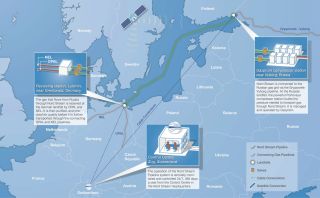Baltic States – CIS, Ecology, Energy, Estonia, EU – Baltic States, Gas, Transport
International Internet Magazine. Baltic States news & analytics
Friday, 26.04.2024, 20:11
Nord Stream publishes annual environmental monitoring results 2011 from Finnish and Estonian waters
 Print version
Print version |
|---|
Nord Stream monitors potential impacts on the Baltic Sea environment caused by the construction and operation of the pipelines in all five countries through whose waters the pipeline passes, according to its national monitoring programmes.
In the Finnish EEZ, the impacts of rock placement on seabed morphology and water quality were monitored during 2011. The monitoring also covered the potential impacts of pipe-laying on seabed morphology and on the condition of cables, barrels and cultural heritage. In addition, upon completion of Line 1 construction the overall impacts of construction on sediment quality have been monitored in Finnish and Estonian waters, and the impacts of the pipeline operation on currents close to the seabed and HELCOM monitoring stations.
In 2011, about 175,000 cubic metres of rock material was placed at altogether 120 berm locations to support the pipelines. The dynamically positioned pipelay barge installed altogether 54 kilometres of Line 1 and 228 kilometres of Line 2, whereas the anchored lay barge installed 148 kilometres of Line 2. Line 1 became operational in November 2011.
Based on these results[1] the actual impacts of pipeline construction and operations were compared with the impacts assessed before the start of construction. The annual monitoring results 2011 support the results of 2010 and show that
- the assessments made during the design phase of the pipelines were conservative and the actual impacts were in line with or less than had been assessed,
- the embedding of the pipelines in soft seabed sediment was greater than assessed, and the freespans were shorter than predicted in the design,
- the total amount of rock material placed up to March 2012 was about 20 percent greater than assessed,
- the impacts of rock placement on water quality near the seabed were local, temporary and short-term,
- the construction works of Line 1 did not cause changes to the concentrations of harmful substances of surface sediment in Finnish or Estonian waters. Metal and dioxin concentrations were generally low. TBT concentrations were generally lower than in 2010,
- pipe-laying did not cause impacts on cables, barrels or the seven wrecks monitored. Some small changes were observed in the features of two wrecks after laying of Line 2. However, they were assessed not to be caused by anchoring of the anchored pipelay vessel,
- the impact of the pipeline on currents was minor in the direct vicinity of the pipeline and negligible at distances greater than 50 meters.
The most important parameter monitored during 2009-2011 in Finnish waters has been water quality. It provides information about the potential spreading of sediment and contaminants contained in it to water due to the construction activities. Prevailing currents affect the extent of sediment spreading. Therefore currents have been monitored in connection with water quality and a separate current monitoring report has been compiled in 2012. The report compares the actual current speeds and directions with the modeled values, which provided the basis for assessing the sediment spreading in the EIA. The results show that the monitored current speeds were generally higher than assessed and there were more currents in the north-south direction than modeled values. The actual impacts of construction works were however in line or less than was assessed. In the EIA the modeling results were multiplied with uncertainty factors to take account of the limitations related to the use of the model in the Gulf of Finland.
Nord Stream's Finnish monitoring programmes were developed based on the environmental impact assessments included in the permit applications. Six independent expert organizations monitor a total of 16 subjects related to the physical, chemical, biological and socio-economic environment.
Along the entire length of the Nord Stream pipeline route, more than 20 companies were contracted to conduct environmental and social monitoring in compliance with the various monitoring programmes. In 2010 and 2011, Nord Stream invested 20 million euros in the programmes. A total of 40 million euros will be invested between 2010 and 2016. Data on 16 subjects are being collected from approximately 1,000 survey locations along the route, and are being analysed in internationally recognised laboratories. The results are reported to the national environmental authorities in each country which oversees the compliance of the project with the local environmental requirements.
Read more on Nord Stream's environmental monitoring here: http://www.nord-stream.com/environment/environmental-monitoring/
[1] Nord Stream Gas Pipeline Construction and Operation in the Finnish EEZ – Environmental Monitoring 2011 Annual Report. Ramboll.








 «The Baltic Course» Is Sold and Stays in Business!
«The Baltic Course» Is Sold and Stays in Business!

